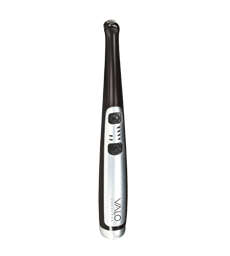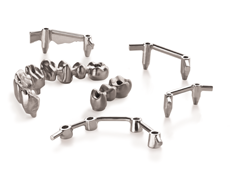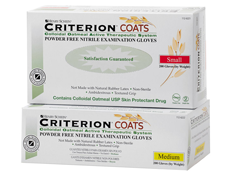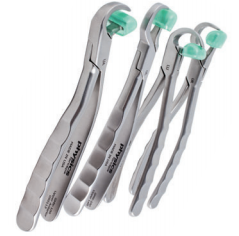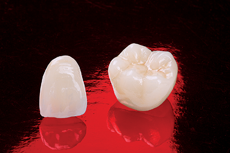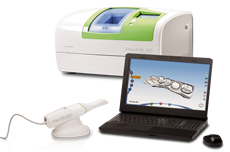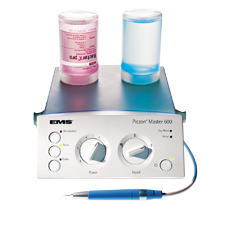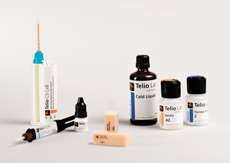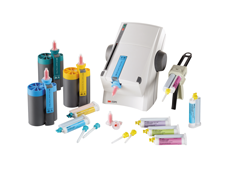Let's talk about money: The 2014 dental fee survey, brought to you by Sikka Software and Dental Products Report
Your dental practice may have the latest technology. Your dental practice may have the most awesome team ever assembled. Your dental practice may be in the shiniest, newest building in town. Your dental practice may run with flawless efficiency thanks to the greatest systems known to mankind. However, if your dental practice doesn’t have money, everything else is moot.
Money is the bloodflow of today’s dental practice. Without it, your practice (which, by the way, is a small business) is doomed to fail.
Much of the money that comes into your practice is based on the fees that you charge for everything from a checkup to an extraction. But how do you know what to charge? If you’re charging too much, your patients are going to be frustrated. If you’re charging too little, you’ve put a real damper on the success of your practice.
Luckily for you, we’re able to give you a peek behind the curtain at what many of your colleagues are charging for different procedures. Thanks to an industry-leading partnership with Sikka Software, we are able to show you, in the following pages, what more than 12,000 dental practices around the country have charged for 20 types of dental procedures over the last four years.
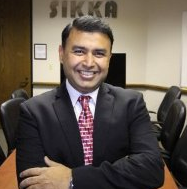
“Data and information is the first step towards knowledge and wisdom for running a more profitable practice,” said Vijay Sikka, founder and president of Sikka Software. “Knowing data is key to knowing and managing the score. If you can measure it you can manage it.”
In addition to the numbers you’ll see on the following pages, you’ll also see expert analysis from Vijay Sikka on each of the 20 codes and the trends over the last four years. With the ups and downs of the last four years, we felt it important for you to see where the industry has been and get a taste for where it’s heading as you plan your fees for 2015.
“2015 is going to be a mixed bag of macro and micro economic fluctuations,” Sikka said. “As a big data company, we are noticing that there is a downward trend emerging in some of the key dental indicators. So, it becomes extremely important that fees are carefully evaluated and aligned for every dental practice with the profitability of that practice. Every dental practice is unique and how you practice is what determines your profitability even more than where you practice.”
On top of all of the data and analysis, we even threw in a product for each of the codes that we think could help your practice maximize the amount you get from each fee. After all we, here at Dental Products Report and Dental Practice Management, believe product and practice management information go hand in hand.
We believe strongly in the power of data. Thanks to our industry-leading partnership with Sikka Software, this data is now yours so you can have the tools you need to make 2015 the best year in your dental practice’s history.
Editor’s Note: The dental procedures codes (“Code”) are owned and published by the American Dental Association (“ADA”) in its reference manual Current Dental Terminology (“CDT”). The ADA is the exclusive owner and copyright holder of the CDT, including the Code, as well as of the ADA claim form.
Shortcuts for each of the highlighted codes and associated fees:
D2330 - Resin-based composite -- one surface, anterior
D3330 - Endodontic therapy, molar
D6010 - Surgical placement of implant body -- endosteal implant
D0120 - Periodic oral evaluation -- established patient
D2790 - Crown full cast, high noble metal
D2740 - Crown -- porcelain/ceramic substrate
D7210 - Surgical removal of erupted tooth
D9940 - Occlusal guard, by report
D0120 - Periodic evaluation -- established patient
D2750 - Crown, porcelain fused to high noble metal
D2950 - Core buildup, including any pins
D4341 - Periodontal scaling and root planing -- four or more teeth per quadrant
D6750 - Crown, porcelain fused to high noble metal
D0150 - Comprehensive oral evaluation, new or established patient
D4910 - Periodontal maintenance
D5110 - Complete denture, maxillary
D5120 - Complete denture, mandibular
D6240 - Pontic, porcelain fused to high noble metal
D7140 - Extraction, erupted tooth or exposed root (evaluation and/or forceps removal)
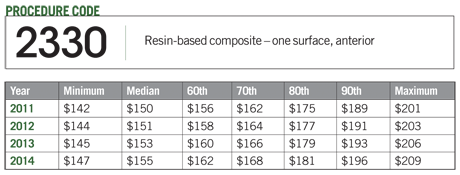
Expert Analysis on dental procedure code D2330
Resin-based composite - one surface, anterior
Resin-based composite refers to a broad category of materials, including but not limited to composites. May also include bonded composite materials and light-cured composites, etc. Tooth preparation, acid etching, adhesives (including resin bonding agents), liners and bases and curing are included as part of this restoration. Glass ionomers, when used as restorations, should also be reported with these codes. If pins are used, they should be reported as a separate procedure.
VALO
The VALO broadband LED curing light uses a custom, multi-wavelength LED to produce high intensity light at 395 to 480 nm, capable of polymerizing all light-cured dental materials. Its three curing options – standard, high power and Xtra power – offer convenience and flexibility, while its slim, ergonomic wand allows access to all restoration sites. In addition, the body design is durable and lightweight.
Ultradent Products
888-230-1420 | ultradent.com

Expert Analysis on dental procedure code D3330
Endodontic therapy, molar
Includes primary teeth without succedaneous teeth and permanent teeth. Complete root canal therapy; pulpectomy is part of root canal therapy. Includes all appointments necessary to complete treatment; also includes intra-operative radiographs. Does not include diagnostic evaluation and necessary radiographs/ diagnostic images.
Endo Intro Kit

This Endo Introductory Kit contains twelve F360™ files in size 025, twelve in size 035, the Komet® AK10 file for canal pre-enlargement, one pack of paper points and a pack of gutta-percha points. The F360 endodontic file system reportedly permits preparation of most root canals with only the two file sizes provided.
Komet USA
888-566-3887 | kometusa.com
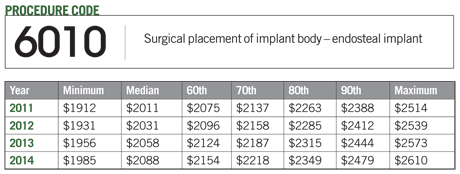
Expert Analysis on dental procedure code D6010
Surgical placement of implant body - endosteal implant
There are three types of implants. The most common is the endosteal implant named for the thin layer of connective tissue lining the bone’s medullary, or “marrow” cavity. The second is a sub-periosteal (or eposteal) implant named after the thin membrane that covers the surface of the bone called the periosteum. The success of an installation of an endosteal implant is contingent on the health of the individual and the amount of healthy bone remaining, and when both the patient and the bone in their jaw is healthy, the endosteal implant is preferred. If not, a sub-periosteal implant is more often than not the only option available. The third type is a transosteal implant, which is either a U-shaped metal frame or pin that is placed along the bottom of the jawbone and extends upward through the bone and the upper gum line. Requiring entry to the jawbone through the skin along the bottom of the patient’s face, and is very infrequently used currently.
CARES
CARES® Screw-Retained Bars & Bridges for the Straumann bone-level and mixed tissue-level and bone-level implant platform are designed to help dental professionals serve a growing population of edentulous patients, and offer patients a solution that can be cost-effective, natural-looking and an improvement in function compared to a traditional gum-supported denture.
Straumann
800-448-8168 | straumann.us

Expert Analysis on dental procedure code D0120
Periodic oral evaluation - established patient
The purpose of an effective periodic oral evaluation is to motivate and educate the patient as to the status of their oral health. The expected results are that the patient will proceed with the appropriate dental treatment once they understand the importance of doing so. If the dentist has followed the initial oral-examination protocol, the result will be a “high dental IQ” patient who is highly motivated to follow their dental treatment plan. The periodic oral examination is commonly the procedure which is more often performed in a dental practice. The ADA defines a “periodic oral evaluation” as an exam that is done on established patients to determine any changes in dental and health status since the previous comprehensive or periodic evaluation. The comprehensive exam lays the foundation for the “routine (periodic) oral eval” and is much more than just a cleaning. It usually is a benefit once in a six-month period with most dental benefit plans.
CRITERION® COATS™
CRITERION® COATS™ protective gloves are enriched with colloidal oatmeal USP, an FDA-recognized therapeutic drug that is said to soothe, moisturize and protect the skin. Through this drug delivery system, the gloves are said to help users maintain the health and integrity of the skin’s natural barriers.
Henry Schein Dental
800-372-4346 | henryscheindental.com
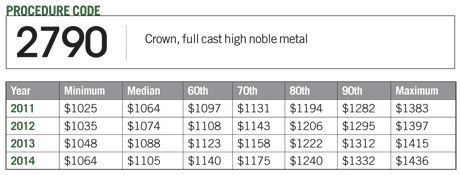
Expert Analysis on dental procedure code D2790
Crown, full cast high noble metal
There are actually three types of materials commonly used for posterior teeth. Gold, which is still the treatment of choice; porcelain, which is unquestionably the most esthetic, and a combination porcelain-fused-to metal (PFM) crown. Gold crowns are made of cast gold, a technique that has been in existence for more than one hundred years. As esthetics become more of a factor, the use of gold is not as large as it once was. Most dentists themselves prefer gold restorations for their own teeth knowing that they will serve well for several decades, in some case more than 50 years. Gold crowns do not have a competitor with regards to long-term service and minimal wear to opposing teeth, which is one of their greatest advantages.
Ti-Max Z900L
The Ti-Max Z900L series of air-driven handpieces features one of the most powerful air turbines at 26 watts of power. It also offers a light titanium body and a DURAGRIP that makes it easier to hold when wet.
NSK Dental
888-675-1675 | nskdental.com
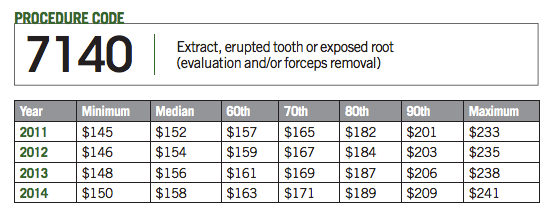
Expert Analysis on dental procedure code D7140
Extraction, erupted tooth or exposed root (elevation and/or forceps removal)
Of all the dental procedures, tooth extraction is amongst a patient’s most feared procedures. Also referred to as exodontia, tooth extraction involves removing a tooth from its socket within the jawbone. Once a dentist has explored all available options, then and only then will this procedure be performed. D7140 includes routine removal of tooth structure, minor smoothing of socket bone, and closure, as necessary. Local anesthesia is usually considered to be part of oral and maxillofacial surgical procedures.
Tooth extraction instrument
Said to be the most clinically effective tooth extraction instrument on the market, it features a patented design and Beak and Bumper technique that makes normally difficult extractions simple and predictable.
Golden Dental Solutions
877-987-2284 | goldendentalsolutions.com
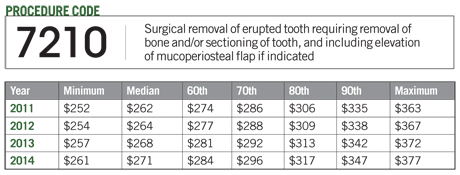
Expert Analysis on dental procedure code D7210
Surgical removal of erupted tooth requiring removal of bone and/or sectioning of tooth, and including elevation of mucoperiosteal flap if indicated
The surgical removal of an erupted tooth requiring removal of bone and/or sectioning of tooth, and including elevation of mucoperiosteal flap if indicated. Includes cutting of gingiva and bone, removal of tooth structure, minor smoothing of socket bone and closure. Includes related cutting of gingiva and bone, removal of tooth structure, minor smoothing of socket bone and closure.
GUIDOR Allograft
Complimenting the line of GUIDOR Matrix Barriers, GUIDOR Allograft is available in mineralized cortical particulate, mineralized cancellous particulate and 50/50 premixed blend of cortical/cancellous particles. The bone grafting material uses Allowash XG® technology to achieve a Sterility Assurance Level of 10.
Sunstar Americas Inc.
877-484-3671 | sunstar.com
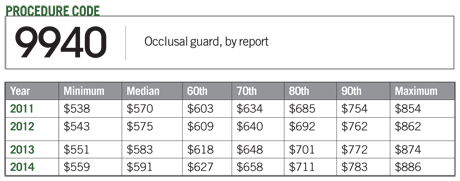
Expert Analysis on dental procedure code D9940
Occlusal guard, by report
The occlusal guard (D9940) and the occlusal orthotic device (D7880) are often confused. Report D9940 to describe an occlusal guard for minimizing the effects of “bruxism” and “clenching of teeth.” Use D7880 to report an appliance provided to treat TMJ dysfunction. Removable dental appliances, which are designed to minimize the effects of bruxism (grinding) and other occlusal factors. The occlusal guard fee will typically vary from $250 to $595, depending on the type of appliance. Factors such as the laboratory bill, the clinical technique used, and the total number of visits for impressions, delivery and follow up may affect the fee charged. Occlusal guards usually require two or more visits to deliver the appliance.
NTI-tss Plus™ Soft

The NTI-tss Plus™ Soft provides maximum patient comfort and significantly reduced chair time. The NTI-tss Plus Soft is a custom fit device consisting of a Hard/Soft thermoformed material with a clinically unbreakable Clear 450® Discluding Element (DE).
Keller Laboratories
800-325-3056 | kellerlab.com

Expert Analysis on dental procedure code D0120
Periodic oral evaluation - established patient
A complete series of radiographs is generally taken after the evaluation of the new patient at the comprehensive oral evaluation (D0150) or (D0180). Radiographic images are also ordered by the dentist per the requirements of the patient. A complete series (D0210) helps to establish a diagnostic baseline. The complete series may be repeated on a three- to five-year basis depending on the needs of the patient. Most payors are now trending toward a five-year reimbursement limitation rather than the more traditional three-year benefit exclusion. This limitation period can differ from plan to plan.
DEXshield
DEXshield is a positioning device for use with the DEXIS Platinum Sensor while also functioning as a personnel protective shield. It serves to align the sensor with the X-ray beam and protect the patient, the operator or other persons from radiation exposure by providing an attenuating barrier that reduces absorbed dosage by 34%.
DEXIS
888-883-3947 | dexis.com

Expert Analysis on dental procedure code D2750
Crown, porcelain fused to high noble metal
Few procedures have withstood the test of time as much as the use of full dental crowns. They are regularly used by dentists as a means of improving badly broken-down teeth. The biggest differences between the types of crowns used in dentistry is the material which makes up the unit.
Data allows the health care practitioner to track the trends within their office and to compare their performance to that of others in the same field. Tracking D2740’s can provide trends that indicate that in house preparation, via CAD/CAM units, may be a more profitable, less time consuming and eliminates the need for two visit preparations and delivery. Big data can provide the User with KPI’s which rank the provider amongst other General Dentists throughout the Nation. Data can guide the User to improve their performance both through additional clinical education or improvement of that most valuable of all resources, communication. Crowns generally last about five to eight years and with data to track the dental team can help extend that time with good oral hygiene and regular visits, data can help by informing the dental team regarding their patient’s dental care trends.
Obsidian™ lithium silicate ceramic crowns
High-strength Obsidian™ lithium silicate ceramic crowns are indicated for the fabrication of full-contour crowns, 3-unit anterior bridges, veneers, inlays and onlays that are said to exhibit lifelike esthetics and toughness.
Glidewell Laboratories
800-854-7256 | glidewelldental.com

Expert Analysis on dental procedure code D2950
Core buildup, including any pins
Buildups are typically considered “all inclusive” now with any crown code, except in select circumstances. Some insurance carriers will reimburse patients for buildups only in cases of previous endodontic treatment. A few will provide a benefit if the remaining anatomical tooth structure can be described as less than 50 percent and inadequate to provide proper retention of a crown. For this procedure, documenting radiographs are essential as well as a detailed description of the condition of the remaining tooth structure. Intraoral photographs can be very helpful to document the need for buildups, because of a tendency to over utilize this code carriers are more and more requesting additional supporting information before payment.
PlanScan
PlanScan CAD/CAM Restoration System, designed by Plameca and driven by E4D Technologies, can reportedly produce lab-quality restorations in hours instead of days - with remarkable speed and accuracy, intuitive design software, on-site milling and no impressions or powder. The result of this system’s design is a vastly improved restorative process.
Planmeca CAD/CAM Solutions – E4D Technologies
972-234-3880 | planmecacadcam.com
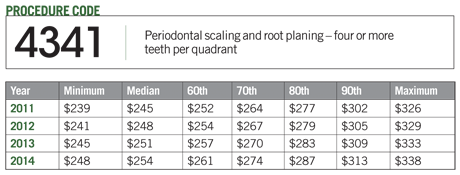
Expert Analysis on dental procedure code D4341
Periodontal scaling and root planing - four or more teeth per quadrant
This procedure involves instrumentation of the crown and root surfaces of the teeth to remove plaque and calculus from these surfaces. It is indicated for patients with periodontal disease and is therapeutic, not prophylactic, in nature. Root planing is the definitive procedure designed for the removal of cementum and dentin that is rough, and/ or permeated by calculus or contaminated with toxins or microorganisms. Some soft tissue removal occurs. This procedure may be used as a definitive treatment in some stages of periodontal disease and/ or as a part of pre-surgical procedures in others.
AIR-FLOW Master Piezon®
The AIR-FLOW Master Piezon® delivers all AIR-FLOW® supragingival and PERIO-FLOW® subgingival air polishing therapies from one side of the device, while the other side offers Piezon® technology with a stand-alone irrigant bottle and LED handpiece.
Hu-Friedy Mfg. Co.
800-HU-FRIEDY | hu-friedy.com
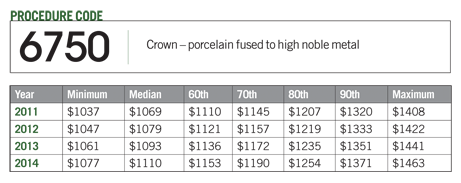
Expert Analysis on dental procedure code D6750
Crown - porcelain fused to high noble metal
This code represents a unit that is utilized to repair chipped, cracked or otherwise damaged tooth. These crowns have a metal base, crowns that contain high noble metal are designated because at least 60% of its composition is of the noble metals gold, platinum, palladium, and silver. Of that 60%, at least 40% of that percentage needs to be gold in order to earn this distinction from the ADA. These “Noble” metals have historically interacted well with human tissues and hold up very well to corrosion and oxidation. The higher the ratio of noble metals the more likely it is to resist corrosion or oxidation. The D2750 is generally used for the replacement of a single unit whereas the D6750 represents the Abutments of a multi-unit bridge.
The noble metal classification system has been adopted as a more precise method of reporting various alloys used in dentistry. The alloys are defined on the basis of the percentage of metal content: high noble – Gold (Au), Palladium (Pd), and/or Platinum (Pt) ≥ 60% (with at least 40% Au); titanium and titanium alloys – Titanium (Ti) > 85%; noble – Gold (Au), Palladium (Pd), and/or Platinum (Pt)≥ 25%; predominantly base – Gold (Au), Palladium (Pd), and/or Platinum (Pt) < 25%. Porcelain/ceramic: Refers to those non-metal, non-resin inorganic refractory compounds processed at high temperatures (600oC/1112oF and above) and pressed, polished or milled– including porcelains, glasses and glass-ceramics. Resin: Refers to any resin-based composite, including fiber or ceramic reinforced polymer compounds.
Telio
Telio is a comprehensive, fully integrated product system for temporary restorations designed for dentists, CAD/CAM users and dental technicians. All Telio materials are well suited for the manufacture of conventional and implant-borne temporaries. The materials are compatible with each other and their shades are optimally coordinated.
Ivoclar Vivadent
800-533-6825 | ivoclarvivadent.com
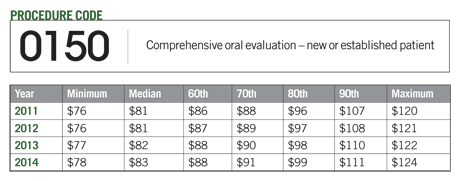
Expert Analysis on dental procedure code D0150
Comprehensive oral evaluation - new or established patient
Used by a general dentist and/or a specialist when evaluating a patient comprehensively. This applies to new patients; established patients who have had a significant change in health conditions or other unusual circumstances, by report, or established patients who have been absent from active treatment for three or more years. It is a thorough evaluation and recording of the extraoral and intraoral hard and soft tissues. It may require interpretation of information acquired through additional diagnostic procedures. Additional diagnostic procedures should be reported separately.
This includes an evaluation for oral cancer where indicated, the evaluation and recording of the patient’s dental and medical history and a general health assessment. It may include the evaluation and recording of dental caries, missing or unerupted teeth, restorations, existing prostheses, occlusal relationships, periodontal conditions (including periodontal screening and/or charting), hard and soft tissue anomalies, etc.
VELscope Vx®
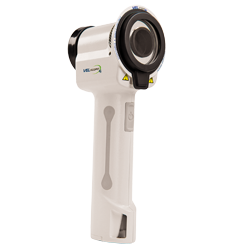
Able to detect tissue abnormalities, the VELscope Vx® enhanced oral assessment system is said to be effective, minimally invasive and can seamlessly be implemented in a patient’s routine dental check-ups. The system’s blue-spectrum light causes the soft tissues of the mouth to naturally fluoresce.
DenMat
805-433-6628 | denmat.com

Expert Analysis on dental procedure code D1110
Prophylaxis - adult
The D1110 prophylaxis is only for patients who do not exhibit any of the signs or symptoms of periodontal disease, including but not limited to bone loss, bleeding, mobility, exudate, and recession. The Prophy is, thus, a preventive procedure for those patients who don’t yet have periodontal disease and should only be used with patients who are periodontally healthy. As the official definition says, D1110 is for “the removal of plaque, calculus, and stains from the tooth structures in the permanent and transitional dentition. It is intended to control local irritational factors.”
Philips Sonicare DiamondClean
Available in white, black and pink, Philips Sonicare DiamondClean is clinically proven to whiten teeth in as little as one week and remove up to seven times more plaque than a manual toothbrush. DiamondClean provides optimal cleaning between teeth and along the gumline for improved gum health in just two weeks.
Philips Oral Healthcare
800-422-9448 | philipsoralhealthcare.com
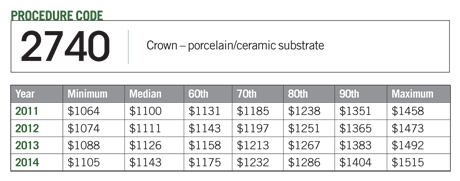
Expert Analysis on dental procedure code D2740
Crown - porcelain/ceramic substrate
With this dental procedure code, the prosthetic crown fitted over the tooth is made entirely of either white porcelain or white ceramic. A crown constructed of either of these materials creates positive cosmetic results, because porcelain emulates a more natural organic look than the “heavier” look of a full ceramic crown. Principally for this reason, a white all porcelain crown is used to repair teeth within the “smile-zone,” of the mouth, where a fully ceramic crown is most often used in the posterior of the mouth.
BeautiBond™
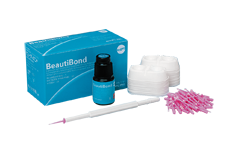
BeautiBond is a 7th generation self-etch, prime, and bond all-in-one product. Unique dual-functioning monomers (phosphonic acid and carboxylic acid) work independently, achieving equal bond strength to dentin and enamel comparable to 6th generation adhesives. Unlike other adhesives, BeautiBond has an ultra-low film thickness of only 5μm providing indistinguishable margins.
Shofu
800-827-4638 | shofu.com
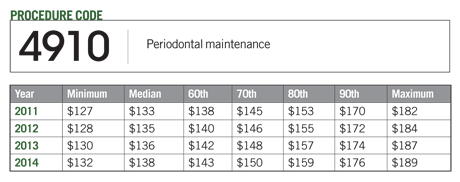
Expert Analysis on dental procedure code D4910
Periodontal maintenance
This visit is a post-therapeutic session used to maintain the results of actual periodontal therapy, and not designed to prevent disease in healthy patients. The CDT for D4910 states that it can only be used “following periodontal therapy and continues at varying intervals ... includes removal of the bacterial plaque and calculus from supragingival and subgingival regions, site-specific scaling and root planing where indicated, and polishing the teeth.” Used following definitive therapy, usually for an indefinite period of time. Many patients have great success in maintenance and may reach a stage where they no longer have signs or symptoms of active disease; little bleeding on probing and more importantly no continuing loss of bone nor attachment. Patients in this category are not smokers and work to have very good to excellent oral hygiene. Others never get to this point, they may present with poor oral hygiene, smoke, and continue to exhibit bone loss and/or excessive bleeding and have not achieved an acceptable level of stability and good health.
Cavitron® FITGRIP™
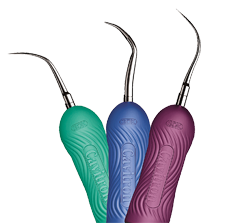
Cavitron® FITGRIP™ ultrasonic inserts are ergonomically designed with clinician’s fingers in mind, allowing the hygienist’s grip to conform to its one-piece design. Also, a large diameter silicone grip reduces muscle load and pinch force. The FITGRIP is available in nine 30K Cavitron insert tip shapes, including Focus Spray®, slimLINE®, PowerLINE®, and THINsert®.
DENTSPLY Professional
800-800-2888
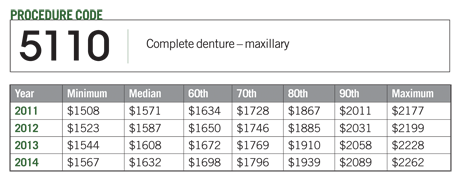
Expert Analysis on dental procedure code D5110
Complete denture - maxillary
Dentures are a treatment option that is an acceptable way to replace function and missing teeth in a patient’s mouth. Many practitioners find the creation of prostheses both frustrating and difficult. The fabrication and getting the “right fit” can be challenging and this group of patients also has the highest percentage of dental complaints overall. The loss of the problematic natural teeth is often considered a way to eliminate dental problems; however, a removable prosthesis is actually the beginning of a new realm of challenges. In spite of these concerns, when treatment planned and fabricated correctly, the outcome for partials and dentures can be predictable as well as beneficial for the patients.
Imprint™ 4 VPS Impression Material
Billed as the fastest impression material on the market, Imprint™ 4 VPS Impression Material reportedly sets in just 75 seconds. Additionally, Imprint 4 VPS provides the same long lasting time of Imprint 3 VPS, but speeds up the set time with an active self-warming features developed specifically for this product.
3M ESPE
800-634-2249 | 3mespe.com
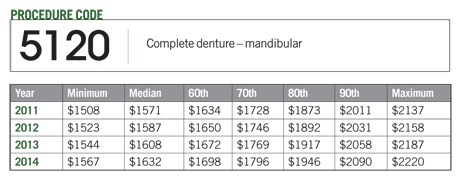
Expert Analysis on dental procedure code D5120
Complete denture - mandibular
Dentures are a treatment option that is an acceptable way to replace function and missing teeth in a patient’s mouth. Many practitioners find the creation of prostheses both frustrating and difficult. The fabrication and getting the “right fit” can be challenging and this group of patients also has the highest percentage of dental complaints overall. The loss of the problematic natural teeth is often considered a way to eliminate dental problems; however, a removable prosthesis is actually the beginning of a new realm of challenges. In spite of these concerns, when treatment planned and fabricated correctly, the outcome for partials and dentures can be predictable as well as beneficial for the patients.
Take 1
The Take 1 Advanced vinylpolysiloxane (VPS) impression material employs Kerr’s expertise in developing high-performance impression materials, along with recent technological advancements, to deliver the first system of VPS materials with an optimum combination of physical properties: strength, elasticity, dimensional stability and the ability to register detail in any environment.
Kerr
800-537-7123 | kerrdental.com
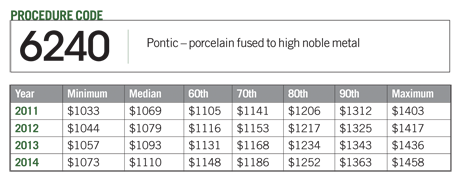
Expert Analysis on dental procedure code D6240
Pontic - porcelain fused to high noble metal
Pontic – porcelain fused to high noble metal unit used to document missing tooth spaces when creating a porcelain Bridge. The provider will use the follow codes D6750 & D6240 for all involved tooth spaces that require a Pontic. Bridge codes are located under the category “Fixed Prosthetics” and are used to improve both function and aesthetics in the patient’s mouth. Pontic and Abutments are fused together to form a bridge.
VERSA-TEMP 2
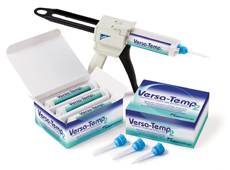
VERSA-TEMP 2 Temporary Crown and Bridge Resin offers 450 MPa compressive strength, plus a total set time of only four minutes. Also, the naturally fluorescent temporaries are said to be easy to adjust and trim, as well as easily polished with an alcohol wipe. VERSA-TEMP 2 is available in 50ml cartridges, in shades A1, A2 and A3.
Sultan Healthcare
800-637-8582 | sultanhc.com
